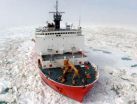(Press-News.org) Coral reefs are among the ecosystems most severely threatened by global warming, but hopeful new evidence has emerged that some coral species may be able to adapt to warmer oceans.
In a study published in the journal PLoS One, an international team of researchers reports that coral populations which unexpectedly survived a massive bleaching event in 2010 in South-East Asian waters had previously experienced severe bleaching during an event in 1998.
The team analysed what happened at three sites during the 2010 event and found that in Indonesia, corals responded to higher sea temperatures in a typical way, with fast-growing branching species - such as staghorn corals – suffering severe die-offs. But at sites monitored in Singapore and Malaysia, the usual trend was reversed: normally susceptible colonies of fast-growing Acropora corals appeared healthy and fully pigmented, while most colonies of massive coral were severely bleached.
"Mass coral-bleaching events, caused by a breakdown in the relationship between the coral animals and their symbiotic algae, are strongly correlated with unusually high sea temperatures and have led to widespread reef degradation in recent decades," notes lead author Dr James Guest, currently a joint research fellow at the UNSW Centre for Marine Bio-innovation and the Advanced Environmental Biotechnology Centre at Singapore's Nanyang Technological University..
"The severity of these events varies considerably but until now we've seen one consistent trend: certain types of coral tend to be more resistant to bleaching than others. This has led to the prediction that hardier, slow-growing massive species will replace less hardy, fast-growing branching species on reefs in the future.
"But during the 2010 event the normal hierarchy of species susceptibility was reversed in some places. Corals at our Indonesian study site in Pulau Weh, Sumatra, followed the usual pattern, with around 90% of colonies of fast-growing species dying. But the pattern was the opposite at study sites in Singapore and Malaysia, even though sea-temperature data showed that the magnitude of thermal stress was similar at all sites.
"This suggests that the thermal history of these sites may have played an important role in determining the bleaching severity in 2010.
"When we looked at archived sea-surface temperature data and past bleaching records we found that the locations that had a reversed hierarchy of susceptibility and less severe bleaching in 2010 also bleached during 1998. In contrast, the site that had a normal bleaching hierarchy and severe bleaching did not bleach in 1998.
"The most parsimonious explanation, therefore, is that coral populations that bleached during the last major warming event in 1998 have adapted and/or acclimatised to thermal stress. This is controversial because many scientists believe that corals have exhausted their capacity to adapt to thermal stress."
While these results are encouraging, Dr Guest says, it does not necessarily mean that the global threat to reefs has lessened. There are likely to be limits to thermal adaptation and acclimatisation, and there may be other costs to the corals, such as reduced growth and reproductive health. As well, reefs continue to be threatened by overfishing, pollution, diseases and ocean acidification.
"The results of the present study do indicate, however, that the effects of coral bleaching will not be as uniform as previously thought and fast-growing branching taxa such as Acropora and Pocillopora are likely to persist in some locations despite increases in the frequency of thermal stress events."
INFORMATION:
Global warming threat to coral reefs: Can some species adapt?
2012-03-12
ELSE PRESS RELEASES FROM THIS DATE:
Strengthening the bond between policy and science
2012-03-12
One only has to be reminded of the BSE crisis and the MMR vaccine scare to recognise the importance of having policy informed by the best available science. Now, a collaboration of over fifty academics and policy makers from around the world have come together to agree a new research agenda on the role of science in public policy. The findings appear today Friday, 09 March in PLoS ONE, a leading interdisciplinary open-access journal.
The importance of using science for public policy has long been recognised, but recent years have seen a growing debate over how this is ...
Bite the hand that feeds...
2012-03-12
LONDON – (March 8, 2012) -- Ecotourism activities that use food to attract and concentrate wildlife for viewing have become a controversial topic in ecological studies. This debate is best exemplified by the shark dive tourism industry, a highly lucrative and booming global market. Use of chum or food to attract big sharks to areas where divers can view the dwindling populations of these animals has generated significant criticism because of the potential for ecological and behavioral impacts to the species. However, the debate has been largely rhetorical due to a lack ...
Literal Lucy to the rescue: A new way to distinguish between literal meaning and contextual meaning
2012-03-12
Washington, DC – A new linguistic study of how individuals interpret various types of utterances sheds more light on how literal and contextual meaning are distinguished. The study, "A novel empirical paradigm for distinguishing between What is Said and What is Implicated," to be published in the March 2012 issue of the scholarly journal Language, is authored by Ryan Doran, Gregory Ward, Meredith Larson, Yaron McNabb, and Rachel E. Baker, a team of linguists based at Northwestern University. A preprint version is available online at:
http://lsadc.org/info/documents/2012/press-releases/doran-et-al.pdf
Within ...
Osteoarthritis Summit delineates shortcomings of research and path forward
2012-03-12
A recent summit that brought together international multidisciplinary experts has provided a foundation for addressing what is the leading cause of disability in the United States: osteoarthritis.
Currently, validated pharmacologic interventions do not exist for effectively eliminating pain and restoring function during progression of osteoarthritis, a disease whose prevalence is expected to dramatically rise within the next decade and inflict a huge economic impact on society. The summit, which was hosted by Hospital for Special Surgery in New York City, is a first ...
Mid-Atlantic suburbs can expect an early spring thanks to the heat of the big city
2012-03-12
If you've been thinking our world is more green than frozen these days, you're right. A recent study has found that spring is indeed arriving earlier – and autumn later – in the suburbs of Baltimore and Washington, D.C. The reason? The urban landscape traps heat in the summer and holds it throughout the winter, triggering leaves to turn green earlier in the spring and to stay green later into autumn. The result is a new, extended growing season.
Scientists used high-resolution satellite data collected over the past 25 years to look at the number days that trees have green ...
LA BioMed investigator, Dr. Rowan Chlebowski, co-authors study on menopausal hormone therapy
2012-03-12
LOS ANGELES (March 9, 2012) – Rowan T. Chlebowski, M.D., Ph.D., an LA BioMed investigator whose research activities have focused on breast cancer therapy and prevention, and chronic diseases impacting women's health, is co-author of a study that indicates that women who use the estrogen-only form of menopausal hormone therapy appear less likely to develop breast cancer in the longer term, according to new research which was recently published The Lancet Oncology.
A follow-up study of over 7,500 women from the Women's Health Initiative (WHI) trial who took estrogen for ...
Health monitoring? There's an app for that
2012-03-12
Researchers in New Zealand have developed a prototype Bluetooth-enabled medical monitoring device that can be connected wirelessly to your smart phone and keep track of various physiological parameters, such as body temperature, heart rate, blood pressure and movements. The prototype could be extended to include sensors for other factors such as blood glucose as well as markers for specific diseases. The connectivity would allow patients to send data directly to their healthcare provider and receive timely advice and medication suggestions.
Writing in the International ...
Environmentally friendly cleaning and washing
2012-03-12
Detergents are everywhere – in washing powders, dishwashing liquids, household cleaners, skin creams, shower gels, and shampoos. It is the detergent that loosens dirt and fat, makes hair-washing products foam up and allows creams to be absorbed quickly. Up until now, most detergents are manufactured from crude oil – a fossil fuel of which there is only a limited supply. In their search for alternatives, producers are turning increasingly to detergents made from sustainable resources, albeit that these surfactants are usually chemically produced. The problem is that the ...
TacSat-4 enables polar region SatCom experiment
2012-03-12
WASHINGTON -- The U.S. Coast Guard Cutter HEALY (WAGB 20) successfully experimented with NRL's TacSat-4 communications satellite, Jan. 24, by communicating from the Bering Sea off the western coast of Alaska to Coast Guard Island, Alameda, Calif.
Returning from an escort and icebreaking mission to Nome, Alaska, assisting the Russian tanker Renda delivery of emergency fuel to the town, USCGC HEALY — Coast Guard's only polar icebreaker — was approximately 260 nautical miles south of the Arctic Circle at the time of the test.
Deployed into a unique, highly elliptical ...
Mapping the Moho with GOCE
2012-03-12
The first global high-resolution map of the boundary between Earth's crust and mantle – the Moho – has been produced based on data from ESA's GOCE gravity satellite. Understanding the Moho will offer new clues into the dynamics of Earth's interior.
Earth's crust is the outermost solid shell of our planet. Even though it makes up less than 1% of the volume of the planet, the crust is exceptionally important not just because we live on it, but because is the place where all our geological resources like natural gas, oil and minerals come from.
The crust and upper mantle ...




